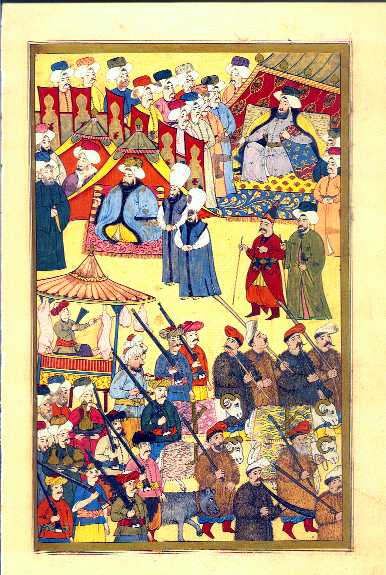The
parade of the guildsmen: Butchers, cooks, and tanners
|
|
|
|
|
78a |
|
77b |
In this scene we see the second parade on the sixth day: the procession
of the Butchers, Cooks, and Tanners guilds. The sultan appears in the upper right
corner of (77b) sitting in his tent. (Because of the crowded nature of this
scene, Levni apparently took it upon himself to move the sultan out of his
observation tower. Vehbi makes no mention of such a change in location.)
Leading the procession in the lower right corner of the same frame are four
pensive-looking rams with gilded horns and dressed in coverlets that look as if
they are fashioned from silk brocade. Flanking them on either side are
shepherds dressed in cloaks of sheepskin with the wool-side turned out. Some of
them are playing a flute; two are playing a horn-shaped instrument; and the
rest are carrying what seem to be staffs. A dark gray curly-coated shepherd dog struts faithfully by midway along
the bottom edge of the frame. The natural outcome of the first contingent of
the parade is shown in the second in the form of a butcher’s shop that is
mounted on a litter and from whose eaves sheep carcasses in various stages of
dismemberment are depicted along with a cleaver-wielding young butcher’s
apprentice. In the lower right corner of (78a) two bovine-looking animals with
gilded horns and incongruously fitted with saddle cloths, saddles, and stirrups
march along. They are accompanied by, according to Vehbi, cattle-butchers.
Following them is a gigantic dummy, the details of which Levni has depicted
rather differently from Vehbi’s description: the artist has portrayed the
figure as having a male and female face and the arm on the female side clasps
the image of a child. The next contingent is a group of cooks and kebab-makers.
A youth kneeling before a working domed oven holds a poker in one hand while he
cooks kebabs with the other. Skewers of kebabs are suspended from a wire frame
alongside the oven. Next come the tanners accompanied by a marching band,
singers, and performers. Bringing up the rear is another litter depicting a
shop in which a seated youth pretends to be selling the tanned hides suspended
from the eaves.
Notes
1. Shepherd dog:
This is the earliest known authentic image of a Turkish shepherd dog. For an enlargement, click here.
2. Cattle-butchers:
In Ottoman times, butchers were divided into guilds according to the type of
animal they slaughtered and sold the flesh of.
Return
to Surname-i Vehbi
index
Return
to Kanyak's
Doghouse

